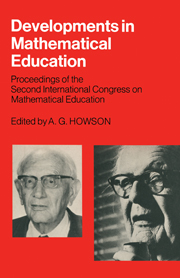 Developments in Mathematical Education
Developments in Mathematical Education Book contents
- Frontmatter
- Contents
- Editor's Acknowledgements
- PART I A CONGRESS SURVEY
- PART II THE INVITED PAPERS
- PART III A SELECTION OF CONGRESS PAPERS
- Investigation and problem-solving in mathematical education
- Intuition, structure and heuristic methods in the teaching of mathematics
- Mathematics and science in the secondary school
- Geometry as a gateway to mathematics
- The International Baccalaureate
- The role of axioms in contemporary mathematics and in mathematical education
- Implications of the work of Piaget in the training of students to teach primary mathematics
- Are we off the track in teaching mathematical concepts?
- Appendices
- Index
The role of axioms in contemporary mathematics and in mathematical education
from PART III - A SELECTION OF CONGRESS PAPERS
- Frontmatter
- Contents
- Editor's Acknowledgements
- PART I A CONGRESS SURVEY
- PART II THE INVITED PAPERS
- PART III A SELECTION OF CONGRESS PAPERS
- Investigation and problem-solving in mathematical education
- Intuition, structure and heuristic methods in the teaching of mathematics
- Mathematics and science in the secondary school
- Geometry as a gateway to mathematics
- The International Baccalaureate
- The role of axioms in contemporary mathematics and in mathematical education
- Implications of the work of Piaget in the training of students to teach primary mathematics
- Are we off the track in teaching mathematical concepts?
- Appendices
- Index
Summary
What do we mean by ‘Axiomatics’?
Modern mathematics, as it has developed during the last century and is still progressing, is characterised both by the axiomatic method and a tendency to abstractness. There are two types of mathematics constructed axiomatically, namely, categorical and non-categorical theories. Examples of the former are Euclidean geometry and the theory of the natural numbers, and of the latter, group, ring, field, vector space and metric space. Roughly speaking, the former is an axiomatisation of a substance – an entity – and the latter is an abstraction of a structure.
A categorical theory can be constructed in two different ways. One way is to discover the essential basis, look for the foundation of a theory, and axiomatise the theory. This is in the spirit of Euclid and Hilbert and may be called the historical development. Historical Euclidean geometry, Hilbert's rigorous theory and Peano's theory of the naturals are examples of this historical development.
The other way is as follows. First, we break down a theory into essential pieces, observe some similarity in different theories, and abstract a common structure. Thus we obtain a non-categorical theory. Next, we organise several non-categorical theories to characterise a categorical theory. This is in the spirit of modern mathematics and may be called the modern development. Thus, an approach in which the Euclidean plane is characterised as a two-dimensional linear space with an inner product typifies this development.
- Type
- Chapter
- Information
- Developments in Mathematical EducationProceedings of the Second International Congress on Mathematical Education, pp. 262 - 271Publisher: Cambridge University PressPrint publication year: 1973
- 2
- Cited by
